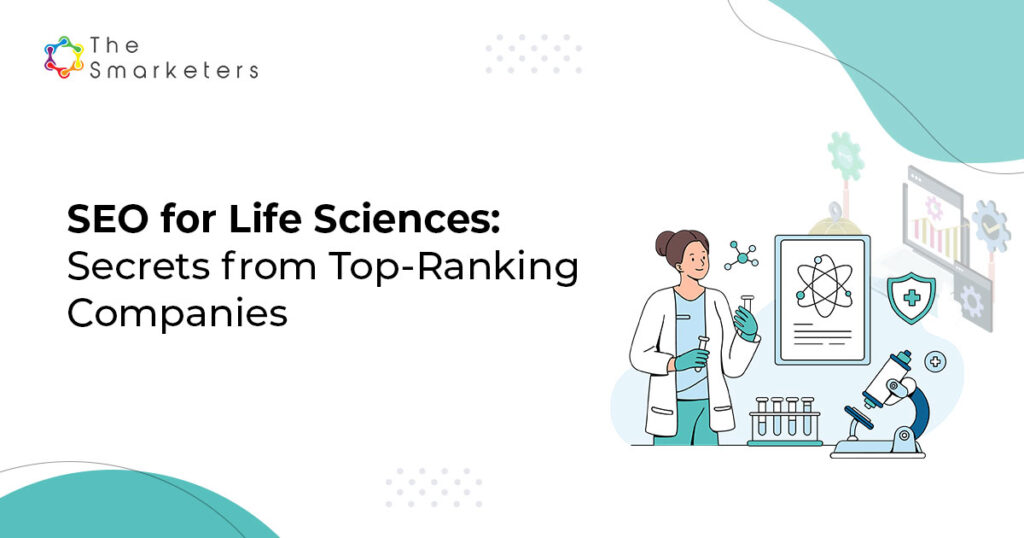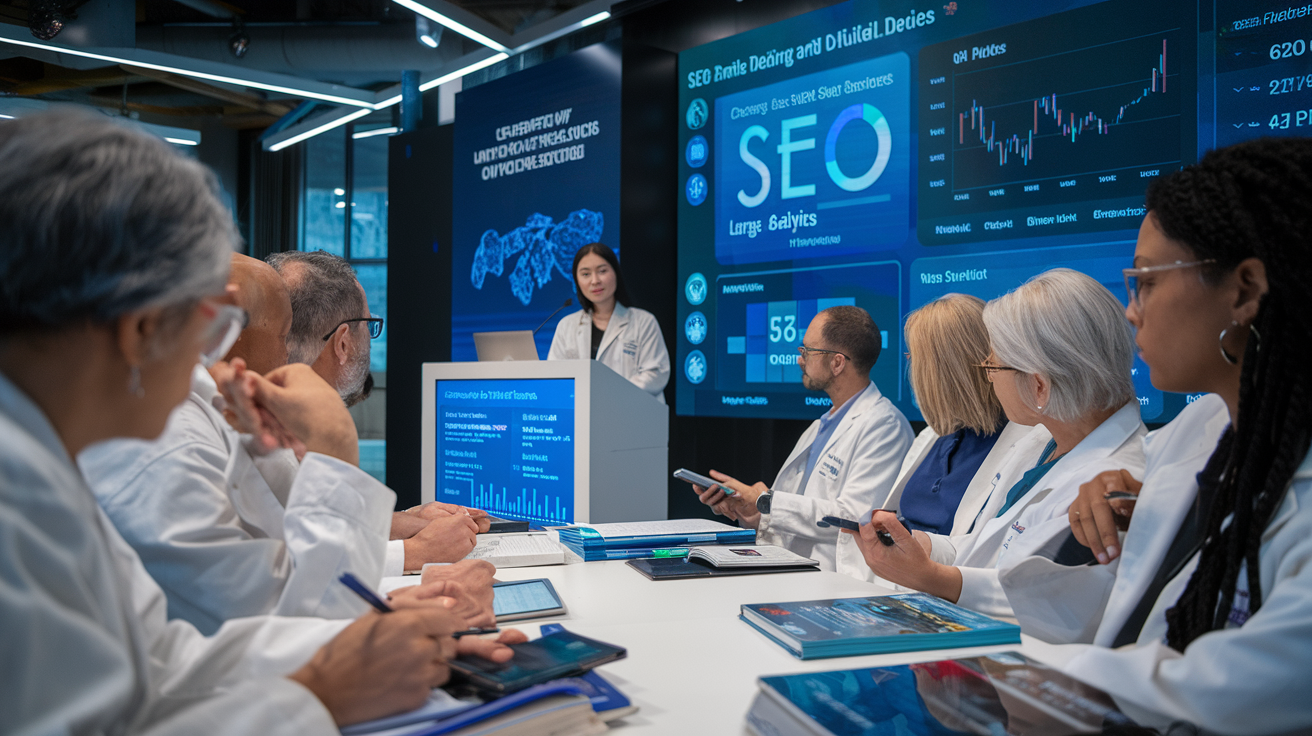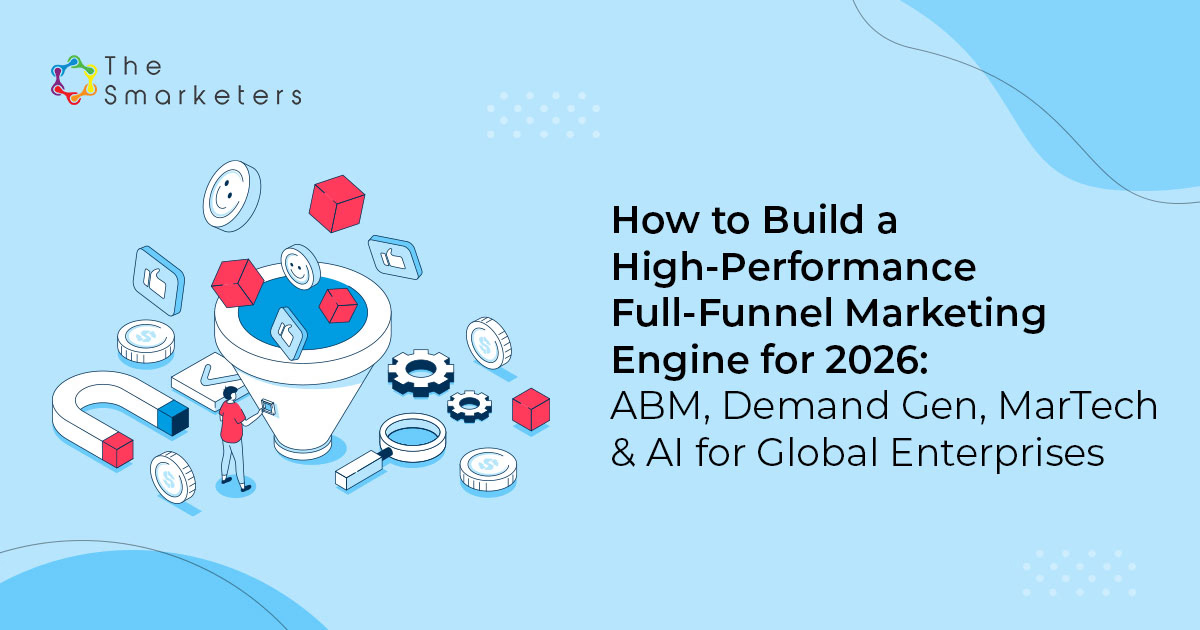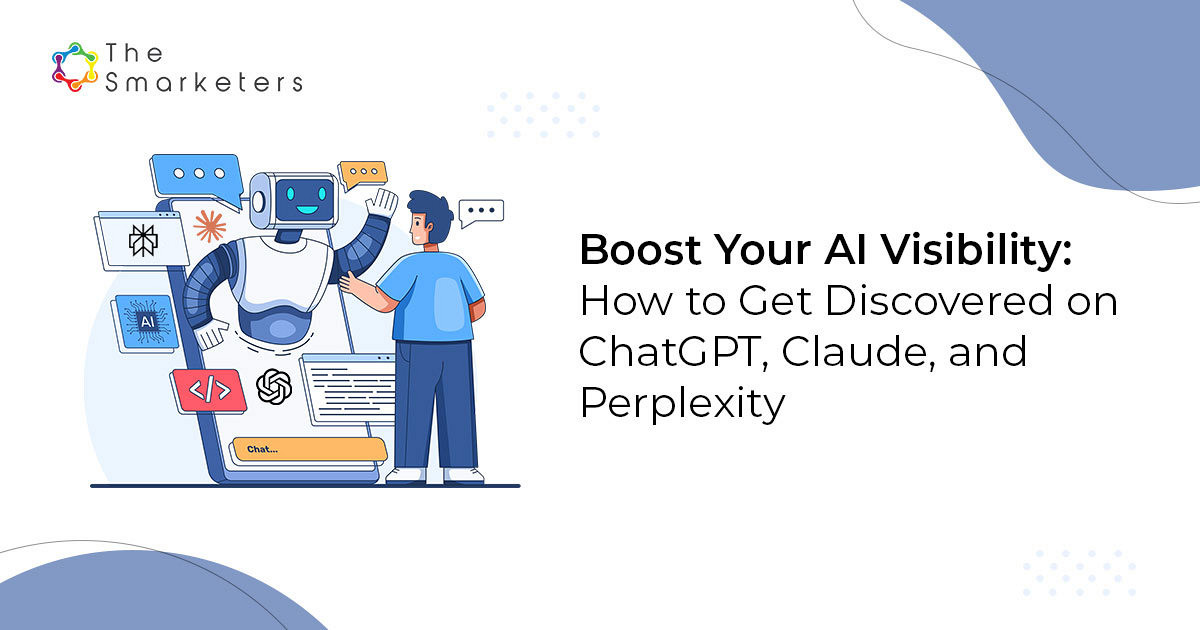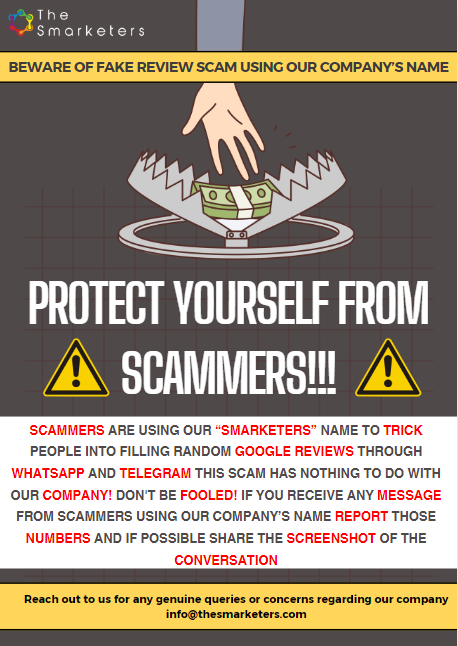Table of Contents
- Understanding Life Sciences SEO Fundamentals
- Keyword Research Strategies for Scientific Topics
- Content Development That Ranks and Converts
- Technical SEO Elements for Life Sciences Websites
- Building Authority in Scientific Communities
- Measuring Success with Life Sciences SEO
- How to optimize SEO and Content for AI Search
- Conclusion
- FAQs
Are you tired of watching competitors capture the top search rankings while your life science content remains buried on page 3? You’re not alone. A shocking 67% of life science companies consistently underperform in organic search despite having superior products and research.
SEO for life sciences isn’t just about keyword stuffing or technical fixes. It’s about understanding the unique search patterns of researchers, healthcare professionals, and informed patients.
In this post, you’ll discover the exact SEO strategies that companies like Illumina, Thermo Fisher, and Abbott use to dominate search rankings while maintaining scientific credibility.
The most successful life science companies have one SEO secret in common – and it’s not what you might expect from typical digital marketing advice.
Understanding Life Sciences SEO Fundamentals
Key differences between general SEO and life sciences SEO
When you’re working in life sciences SEO, you’re not just dealing with ordinary search patterns. The scientific realm plays by different rules.
Your typical B2C or B2B SEO strategies fall short here because life sciences audiences aren’t looking for quick solutions – they’re searching for credible research, validated methodologies, and evidence-based information. While general SEO might prioritize conversion rates and buying patterns, life sciences SEO zeroes in on building trust and establishing scientific authority.
Consider this comparison:
| General SEO | Life Sciences SEO |
|---|---|
| Short attention spans | Deep research sessions |
| Emotion-driven keywords | Technical terminology |
| Broad market appeal | Niche expert audiences |
| Fast decision cycles | Extended consideration phases |
| Visual content priority | Data-backed content critical |
Industry-specific search patterns and researcher behaviors
Scientists don’t Google like the rest of us. When you’re optimizing for life sciences, you need to recognize that your audience performs highly specific, technically sophisticated searches.
Researchers typically use:
- Longer, more detailed queries
- Scientific terminology without simplification
- Boolean operators to refine searches
- Advanced filters to locate specific study types
Your keyword research must account for these behaviors. A biotech researcher might search “CRISPR-Cas9 T cell immunotherapy clinical trials phase 2” rather than “new cancer treatments.”
Lab professionals often skip Google entirely, heading straight to PubMed, Science Direct, or specialized databases. This means your SEO strategy must extend beyond traditional search engines.
Regulatory considerations affecting content strategy
Regulatory oversight changes everything about your content approach. You can’t just claim your biotech product “works better” without proper evidence.
FDA, EMA, and other regulatory bodies impose strict guidelines on what you can say and how you can say it. Your content strategy must navigate:
- Off-label promotion restrictions
- Fair balance requirements
- Clinical evidence standards
- Data presentation guidelines
Smart life sciences SEO means creating compliant content that still ranks well. You’ll need disclaimers, references, and careful wording while maintaining readability and search relevance.
Technical SEO requirements for scientific content
Your technical SEO game needs extra attention in life sciences. Beyond the usual site speed and mobile optimization, you’re dealing with:
- Complex data visualization needs
- Research papers and lengthy PDFs
- Citation and reference structures
- Scientific schema markup opportunities
Make sure your site architecture supports detailed taxonomies for organizing complex subject matter. Implement proper structured data to help search engines understand scientific relationships in your content.
Keyword Research Strategies for Scientific Topics
Identifying high-value scientific terminology
Finding the right scientific terms for your SEO strategy isn’t just about grabbing jargon – it’s about understanding what your audience actually searches for.
Start by tapping into your internal expertise. Your scientists and researchers already know the language your audience uses. Ask them which terms come up in conferences or what terminology they use when explaining concepts to colleagues.
PubMed and Google Scholar aren’t just for research – they’re goldmines for keyword ideas. Pay attention to how concepts are described in abstracts and titles of highly-cited papers. Those terms have already proven their value in the scientific community.
But here’s the trick: don’t just focus on the most technical terms. Your audience searches across a spectrum:
| Search Type | Example | Who’s Searching |
|---|---|---|
| Basic | “CRISPR basics” | Students, journalists, general public |
| Intermediate | “CRISPR Cas9 applications” | Scientists in adjacent fields, investors |
| Advanced | “CRISPR off-target effects mitigation” | Specialists, researchers in the field |
Capture all three levels in your keyword strategy to maximize your reach.
Balancing technical accuracy with search volume
The eternal struggle in life sciences SEO: do you use the scientifically perfect term that nobody searches for, or the slightly less accurate term that gets traffic?
You need both. For your primary pages, target the terms with decent search volume that aren’t technically wrong – just more accessible. Then create supporting content that uses the hyper-technical terminology your specialists expect.
A smart approach is to educate while you optimize. If the common search term is “gene editing” but you really want to rank for “CRISPR-mediated genome modification,” create content that starts with the simpler term and gradually introduces the more precise language.
Competitor keyword analysis in the life sciences space
Your competitors leave digital breadcrumbs about their keyword strategy everywhere – you just need to know where to look.
Don’t just analyze obvious competitors. In life sciences, you’re often competing with:
- Academic institutions
- Government resources (NIH, CDC)
- Industry associations
- Scientific journals
- Patient advocacy groups
Tools like Semrush and Ahrefs let you peek at which keywords drive traffic to these sites. But dig deeper by examining:
- Their publication titles and meta descriptions
- Subheadings and image alt text
- Conference presentation topics
- Clinical trial descriptions
Tools specifically designed for scientific keyword research
Regular keyword tools don’t always cut it for life sciences. They miss the nuance and specialized language of your field.
Try these specialized approaches:
- Use MeSH (Medical Subject Headings) from the National Library of Medicine to identify standardized terminology
- Leverage Google’s Dataset Search for research-focused keywords
- Try PubReMiner to analyze frequency of terms in published literature
- Explore BioToday for trending topics in biotech
Leveraging publication databases for keyword inspiration
Publication databases aren’t just for literature reviews – they’re SEO treasure troves.
When searching databases like PubMed, Science Direct, or Scopus, pay attention to:
- Frequently used keywords in the most-cited papers
- Author-supplied keywords (these often reflect how researchers categorize their work)
- Terms used in systematic reviews (they often capture the full spectrum of search variations)
Look for patterns in how terminology changes over time. Is “precision medicine” replacing “personalized medicine” in recent publications? Your SEO strategy should reflect these shifts.
Content Development That Ranks and Converts
Creating authoritative scientific content
Want to dominate search results in life sciences? Your content needs to scream authority. The scientific community isn’t fooled by fluff—they need substance.
Start by collaborating with actual scientists and researchers in your organization. Their expertise transforms basic content into authoritative resources that both Google and scientists respect. Remember, Google’s E-E-A-T principles (Experience, Expertise, Authoritativeness, Trustworthiness) matter enormously in life sciences.
When developing content, cite peer-reviewed studies and link to reputable sources like PubMed, Nature, or Science. This isn’t just good science—it’s good SEO. These citations build credibility with your audience and search engines simultaneously.
Your content should address specific questions researchers and professionals ask. Use your scientific keyword research to identify these questions, then answer them comprehensively. If you’re writing about CRISPR, don’t just explain what it is—dive into specifics about delivery methods, off-target effects, and practical applications.
Data visualization best practices for engagement
Raw data rarely tells a compelling story on its own. You need effective visualizations to make complex scientific concepts digestible.
When creating data visualizations for life science content:
- Choose simplicity over complexity—focus on the key message
- Maintain scientific accuracy while improving readability
- Use consistent color coding across related charts
- Include interactive elements when possible (users spend 2x longer with interactive content)
Static images work well, but interactive visualizations drive significantly more engagement. Tools like Tableau and D3.js let users explore your data themselves, dramatically increasing time-on-page (a crucial SEO signal).
Balancing technical detail with accessibility
This is the tightrope every life sciences marketer walks. Too technical? You lose broader audiences. Too simplified? Experts dismiss your content.
The solution? Layer your content:
- Start with accessible overviews that anyone can understand
- Progressively introduce more technical details
- Include expandable sections for deep technical content
This approach satisfies both technical and non-technical audiences without sacrificing depth or clarity. Plus, longer, comprehensive content consistently outranks shorter pieces in scientific SERPs.
Content formats that perform best in life sciences
Not all content formats deliver equal SEO value in life sciences. Based on conversion analysis across biotech and pharmaceutical websites:
| Content Format | SEO Performance | Engagement Metrics | Conversion Rate |
|---|---|---|---|
| Case Studies | Excellent | High time-on-page | 3.2% avg |
| White Papers | Very Good | Moderate | 2.8% avg |
| Webinars | Good | Very High | 4.1% avg |
| Infographics | Moderate | High sharing | 1.7% avg |
Webinars and video content consistently drive the highest engagement, while case studies deliver the best balance of SEO performance and conversions.
Technical SEO Elements for Life Sciences Websites
Schema Markup for Scientific Content
Ever noticed how some search results show extra info like star ratings or publication dates? That’s schema markup at work, and it’s a game-changer for your life sciences website.
When you add schema markup to your scientific content, you’re basically giving Google a cheat sheet about what’s on your page. For research papers, clinical trials, or pharmaceutical products, you can tag elements like:
- AuthorCredentials
- StudyFindings
- ChemicalCompounds
- TrialStages
- PublicationDates
This structured data helps search engines understand the complex content on your site. Top biotech companies are using schema to highlight their research credentials and get those coveted rich snippets in search results.
<script type="application/ld+json">
{
"@context": "https://schema.org",
"@type": "MedicalScholarlyArticle",
"headline": "Your Research Paper Title",
"author": {
"@type": "Person",
"name": "Dr. Researcher Name",
"affiliation": "Your Research Institution"
}
}
</script>
Site Architecture Optimized for Research Pathways
Think about how scientists and healthcare pros navigate websites. They don’t browse—they hunt for specific information.
Your site architecture should mirror typical research workflows. Group content by research areas, methodologies, or application fields rather than by marketing categories.
Here’s what works:
- Flat hierarchies (no more than 3 clicks to any important content)
- Clear pathways between related studies or products
- Persistent navigation showing research categories
- Prominent search functionality with filters for publication dates, study types, etc.
The Mayo Clinic website is worth studying—they’ve mastered organizing thousands of complex medical topics in a way that both search engines and researchers can easily navigate.
Mobile Optimization for Lab Professionals
Lab coats and smartphones go hand in hand these days. Your scientific content needs to perform flawlessly on mobile devices.
Consider this: researchers often read studies on their phones between experiments or during commutes. If your mobile experience frustrates them, they’ll bounce faster than a centrifuge.
Mobile optimization for life sciences isn’t just about responsive design—it’s about thinking through typical usage scenarios:
- Can users easily download PDFs of studies?
- Are data tables readable without horizontal scrolling?
- Do complex visualizations scale appropriately?
- Is font size suitable for quick reading in varying lighting conditions?
Page Speed Considerations for Data-Heavy Resources
Scientific websites are notorious for slow loading times. All those high-res microscopy images, interactive models, and data visualizations add up.
But here’s the truth: each second of delay can cost you 7% in conversions. Your audience of scientists might be patient in the lab, but they’re just as impatient online as everyone else.
Speed up your site by:
- Using lazy loading for images and visualizations
- Implementing CDNs for global research audiences
- Compressing research PDFs and offering HTML alternatives
- Using modern image formats like WebP instead of TIFFs
- Minifying your code (yes, even for scientific sites)
Secure Hosting for Sensitive Information
In life sciences, security isn’t just good practice—it’s often legally required. Your technical SEO must account for:
- HIPAA compliance for patient data
- Secure transmission of proprietary research
- Protection of intellectual property
- Regulatory compliance across global jurisdictions
Don’t think security and SEO are separate concerns. Google prioritizes secure sites, and your scientific audience trusts sites that protect their information and research interests.
Implement SSL certificates, regular security audits, and transparent data handling policies. Then make sure your security features don’t interfere with crawler access to public content by using proper robots.txt configurations.
Building Authority in Scientific Communities
Strategic citation and reference linking
Want to know what separates amateur life sciences content from the pros? It’s how you handle citations. When you reference peer-reviewed research properly, you’re not just backing up claims—you’re building trust with scientific audiences who spot poor sourcing from a mile away.
Try this approach: whenever you mention research findings, link directly to the original publication instead of news articles about it. Your scientific audience appreciates this immensely. They’re trained to evaluate sources, and when you save them that step, you earn their respect.
What’s even better? Creating a dedicated references section at the bottom of your content pieces. This isn’t just good scientific practice—it’s excellent SEO. Search engines recognize these citation patterns as indicators of high-quality, authoritative content in the life sciences space.
Collaborative content with research institutions
The fastest way to boost your scientific credibility? Partner with the people who already have it. When you collaborate with research institutions on content, you immediately elevate your brand’s authority.
Consider reaching out to university departments related to your field for co-created content. This might include:
- Guest posts from academic researchers
- Joint webinars on emerging topics in your niche
- Data visualization projects using their research findings
These partnerships create natural, high-value backlink opportunities. When an established research institution links to your content, search engines take notice—this is exactly the kind of healthcare website authority building that moves the needle.
Leveraging scientific credentials effectively
Got PhDs on your team? Put them to work for your SEO strategy. When qualified scientists create or review your content, make this crystal clear to both readers and search engines.
Add author bios highlighting educational backgrounds and research experience. Include “reviewed by” sections featuring your scientific advisors. These simple additions dramatically boost your E-E-A-T signals (Experience, Expertise, Authoritativeness, and Trustworthiness)—critical for life sciences SEO.
Don’t hide your expertise in the background. Feature it prominently where it helps establish why visitors should trust your content over competitors.
Publication-based backlink strategies
The scientific community has its own ecosystem of link-worthy content, and you need to tap into it. Here’s how:
When your company publishes research or presents at conferences, transform those materials into digital assets. Create dedicated landing pages for each publication with shareable visualizations and key findings formatted for the web.
Then promote these assets to:
- Scientific journalists looking for stories
- Industry newsletters needing content
- Academic blogs covering related topics
Each mention creates backlink opportunities that search engines view as especially valuable in technical fields. This targeted approach to scientific community backlinking yields much better results than generic link building tactics.
Measuring Success with Life Sciences SEO
KPIs Beyond Traffic That Matter to Life Sciences Companies
Truth bomb: visitor count isn’t everything in life sciences SEO. Your scientific audience doesn’t behave like typical consumers, and your metrics need to reflect that.
When you’re marketing complex research instruments or pharmaceutical solutions, you need deeper KPIs that match your industry’s unique research cycles. Here are the metrics that actually matter:
- Dwell time on technical content: Are researchers spending 8+ minutes on your methodology pages? That’s gold.
- PDF downloads of white papers: Each download represents a qualified lead investigating your scientific credibility.
- Citation tracking: When your content gets referenced in scientific publications, you’ve hit the SEO jackpot.
- Return rate of research professionals: Scientists returning to your site indicates building authority in your niche.
Track these metrics alongside traditional traffic numbers to get the full picture of your life sciences SEO success.
Attribution Models for Long Research Cycles
Your buyers aren’t making impulse purchases—they’re making carefully researched decisions over months or even years. Standard 30-day attribution models simply don’t cut it.
You need attribution models that respect the scientific decision-making process:
| Attribution Model | Best For | Why It Works |
|---|---|---|
| Position-based (U-shaped) | Equipment purchases | Captures both initial research and final decision phases |
| Time-decay (18+ month window) | Pharmaceutical partnerships | Acknowledges the extended validation period |
| Custom multi-touch | Research collaborations | Tracks numerous touchpoints across various stakeholders |
Pro tip: Set up Google Analytics 4 with extended lookback windows specifically for your high-value conversion paths to capture the full journey of scientific decision-makers.
Tracking Engagement From Scientific Audiences
Scientific professionals engage differently. They’re looking for precision, data integrity, and technical depth—not flashy CTAs.
To measure meaningful engagement from this audience:
- Track highlight/copy behavior on technical sections
- Monitor comment quality on research content (depth of questions matters more than quantity)
- Measure email open rates specifically from .edu and research institution domains
- Track webinar attendance duration—scientists who stay for Q&A are your prime prospects
Create separate segments in your analytics for visitors from research institutions versus general healthcare traffic. The behavioral differences will astound you.
ROI Calculation Methods for Research-Oriented Content
Calculating ROI for life sciences content requires patience and specialized approaches:
ROI = (Value of Scientific Conversions × Conversion Rate) ÷ Content Investment
But here’s the twist—your “value” calculation needs to incorporate:
- Grant funding influenced by your content
- Research partnerships facilitated
- Regulatory approval acceleration
- Reduced customer education costs
For technical SEO content, evaluate performance over 18-24 months, not weeks. Some of your most valuable content might take 6+ months to gain traction as it builds authority within the scientific community.
How to optimize SEO and Content for AI Search
Adapting to AI Search: New Rules for Life Sciences Content
AI search is changing the game for life sciences companies. Gone are the days when stuffing your content with keywords would get you to the top. Now, it’s all about answering real questions that scientists, researchers, and healthcare professionals are asking.
You need to rethink how you create content for this new AI-powered world. Let’s break down what works now:
Focus on Answering Questions, Not Keywords
When a researcher types “latest CRISPR applications in oncology,” they’re not looking for a keyword-stuffed page. They want comprehensive answers. Your content needs to directly address specific questions in depth.
Try this approach: Write down the 5-10 most common questions your scientific audience asks about your specialty area. Then create content that thoroughly answers each one. This naturally incorporates your “scientific keyword research” without forcing it.
Create Topic Clusters for Technical Scientific Content
AI search engines don’t just look at individual pages anymore—they evaluate your entire site’s authority on a subject.
Build topic clusters around your core life science specialties:
- Core pillar page (e.g., “CRISPR Technology”)
- Supporting content (applications, techniques, equipment, case studies)
- Internal linking between related content
This structure signals to AI that you’re a comprehensive resource in your field, boosting your “biotech content optimization” efforts naturally.
Write for Depth and Expertise
The days of 300-word blog posts are over. AI rewards expertise and depth.
You know those technical details you thought were “too complex” for your website? Include them now. AI search can understand the relationships between complex scientific concepts and will rank in-depth, authoritative content higher. This is especially crucial for “SEO for pharmaceutical websites” where accuracy and thoroughness matter.
Optimize for Featured Snippets and Zero-Click Searches
Have you noticed how Google often answers questions directly at the top of search results? These are featured snippets.
Format your life sciences content to win these spots:
- Use clear H3 and H4 headings that include questions
- Provide concise definitions and explanations (50-60 words)
- Include structured data markup for research findings
- Use tables for comparing methods, compounds, or technologies
Voice Search Optimization for Scientific Terms
Your scientific audience is increasingly using voice search, even for complex terms. This means adapting your “life science marketing strategies” to include conversational phrases alongside technical terminology.
For complex scientific terms, include both the technical name and common speech patterns:
- “CRISPR-Cas9 gene editing” AND “how to edit genes using CRISPR”
- “Monoclonal antibody therapies” AND “how antibody treatments work”
By embracing these AI search optimization techniques, you’ll position your life sciences content to rank higher and reach the right audience—exactly when they’re looking for the specialized knowledge you provide.
Conclusion
You’ve seen it for yourself – SEO in the life sciences isn’t just another marketing tactic. It’s your gateway to connecting with researchers, healthcare professionals, and patients who are actively searching for what you offer.
The most successful life sciences companies don’t treat SEO as an afterthought. They weave it into their core marketing strategy because they understand what’s at stake. When someone searches for a lifesaving treatment or a revolutionary research tool, you can’t afford to be invisible.
Remember those key strategies we’ve explored? Scientific keyword research isn’t just about traffic – it’s about speaking the language of your audience. When you optimize your content with terms like “monoclonal antibody specificity” instead of just “antibody products,” you’re showing your audience you understand their needs.
Technical SEO might seem dry, but it’s what makes your breakthrough research discoverable. Your site architecture, meta descriptions, and schema markup are the infrastructure that carries your scientific innovations to the people who need them most.
And let’s talk about content – the cornerstone of life sciences SEO. The days of keyword stuffing are long gone. Today’s search algorithms reward deep expertise, which you already have. Your challenge is translating that expertise into accessible, valuable content that addresses real questions.
Building authority isn’t optional in this industry. Each quality backlink from respected journals, research institutions, and industry partners signals to search engines that you’re a trusted voice in a field where trust is paramount.
Don’t forget – your competition is already implementing these strategies. Top pharmaceutical companies are investing heavily in SEO because they see the ROI. Every position you climb in search rankings translates to more visibility, more trust, and ultimately, more impact.
What will you do differently tomorrow? Start with an audit of your current SEO efforts against the strategies we’ve covered. Identify the quick wins – maybe it’s optimizing your technical SEO or developing a more strategic approach to your content calendar.
The life sciences industry is changing rapidly, and so is search technology. AI-powered search is transforming how people find information. Your SEO strategy needs to evolve accordingly, focusing on answering questions completely and establishing your expertise definitively.
Your work matters too much to remain undiscovered. With these SEO strategies implemented consistently, you’ll ensure your innovations reach the people who need them most. The question isn’t whether you can afford to invest in SEO – it’s whether you can afford not to.
FAQs
What are the most important SEO factors for life sciences companies?
Success in life sciences SEO isn’t about checking every box—it’s about focusing on what actually moves the needle. For your scientific organization, prioritize these game-changers:
- Technical excellence – Your site needs to load fast, work flawlessly on mobile devices, and have a clean architecture that search engines can easily crawl. This isn’t just for Google—it’s for busy researchers and healthcare professionals who will bounce if your site isn’t responsive.
- High-quality scientific content that balances technical accuracy with accessibility. You’re speaking to multiple audiences simultaneously—from scientists who need precise information to patients seeking understandable explanations.
- Structured data markup specifically tailored to scientific content. This helps search engines understand complex relationships between concepts, studies, and findings.
- Authoritative backlinks from respected institutions, journals, and industry partners. One link from Nature or a major research university can outweigh dozens from general websites.
How can I conduct effective keyword research for scientific content?
Scientific keyword research requires a different approach than standard SEO:
- Look beyond the obvious terms. Instead of just “CRISPR technology,” consider what your specific audiences are searching: “CRISPR applications in oncology” or “CRISPR-Cas9 protocol optimization.”
- Pay attention to semantic variations and technical terminology. Scientists might use precise technical terms while patients use more common language for the same concepts.
- Use specialized tools like PubMed, Google Scholar, and scientific conference proceedings to identify trending research topics before they become mainstream search terms.
- Don’t ignore long-tail keywords with research intent—phrases like “mechanism of action for [drug name]” or “comparative efficacy of [treatment] vs [alternative].”
How can I measure the ROI of life sciences SEO efforts?
Your SEO performance metrics should align with your scientific business goals:
- Track not just rankings but conversion actions that matter: contact form completions, white paper downloads, clinical trial sign-ups, or investor information requests.
- Measure dwell time on technical content—are visitors actually reading your detailed scientific explanations or bouncing quickly?
- Set up separate analytics tracking for different audience segments—HCPs, researchers, patients, and investors interact differently with your content.
- Connect your SEO efforts to business outcomes: increased scientific partnerships, talent recruitment success, and ultimately, contribution to revenue growth.
Navigating the complex landscape of life sciences SEO requires a strategic approach that balances scientific accuracy with digital optimization. By focusing on specialized keyword research, creating authoritative content, and implementing technical SEO elements specific to scientific websites, you can significantly improve your visibility in this competitive space. Building credibility within scientific communities and carefully tracking performance metrics will further strengthen your digital presence.
As AI search continues to transform how researchers and professionals find information, adapting your SEO strategy becomes increasingly crucial. Remember that successful life sciences SEO isn’t just about ranking—it’s about connecting valuable scientific information with the people who need it most. Start implementing these proven strategies today to elevate your organization’s digital footprint and establish yourself as a trusted resource in your specific life sciences niche.

